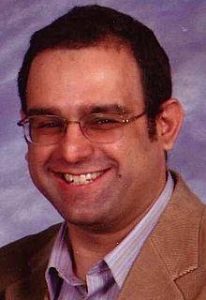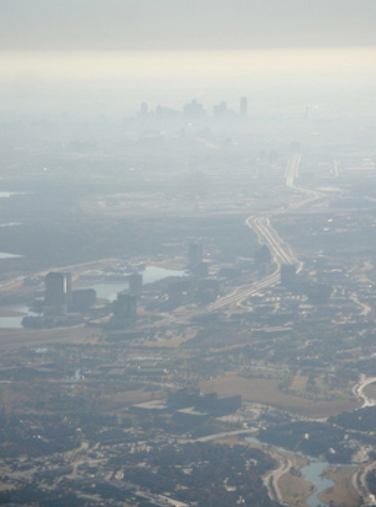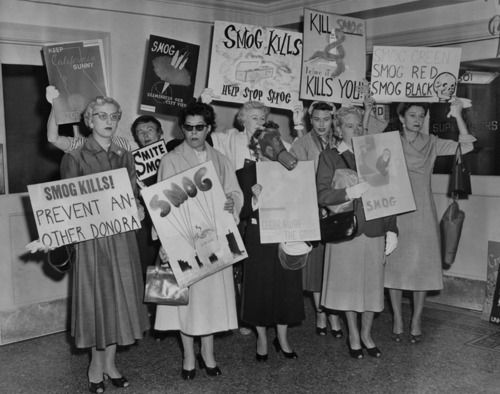Citizen Action
Two New Articles on our Citizen Science Projects
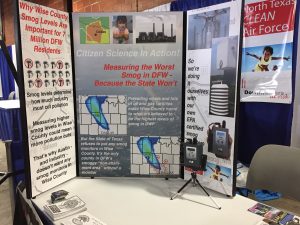 Our local “environmental paper of record” DFW GreenSource has a piece up about the DFW Air Research Consortium’s plan for a local 21st Century air monitoring network that quotes UNT Health Science Center researcher Leslie Allsopp and Downwinders’ Chair Tamera Bounds.
Our local “environmental paper of record” DFW GreenSource has a piece up about the DFW Air Research Consortium’s plan for a local 21st Century air monitoring network that quotes UNT Health Science Center researcher Leslie Allsopp and Downwinders’ Chair Tamera Bounds.
Meanwhile the Texas Observer just put up an article about Downwinders’ Wise County Ozone Project.
Both of these citizen science efforts, plus others, will be covered in each of the three “Evenings of Science and Socializing” we have coming up over the next week, beginning at 7 pm tomorrow night at the Bryan Street Tavern in Old East Dallas. The Dallas Innovation Alliance is the Co-Sponsor, and they have their own sensor pilot project in the West end to brag about. Y’all come.
Citizens Just Won a Fight Over Local Control….Now What?
 In case you missed it, last Thursday the Bluestone company pulled its permit request for a new fracking waste Injection well that was going to be sited on the western shores of Lake Arlington.
In case you missed it, last Thursday the Bluestone company pulled its permit request for a new fracking waste Injection well that was going to be sited on the western shores of Lake Arlington.
Congratulations to Liveable Arlington and everyone else who contributed to this victory. It’s always great when you can stop a bad idea in its tracks, but to stop this one, with the current Powers-That-Be, is quite remarkable.
Bluestone’s application had united a broad spectrum of allies for a Barnett Shale fight – residents, local fractivists, municipalities, and water quality groups. Fort Worth had banned such wells years prior to the passage of notorious HB40, but Bluestone acted like that ban didn’t matter. Arlington objected over its drinking water source being imperiled by the well. Bluestone shrugged its shoulders.
Here was the first challenge to the uneasy truce that settled over the state between home rule cities and Austin after HB40 took effect. And it came not from an aspiring Denton trying to protect its citizens, but from industry. And it wasn’t targeting an upstart city, but the town that industry hailed as a model of gas regulation only two years ago when HB40 passed.
Thousands of letters opposing the permit were sent in to the Railroad Commission. An army of lawyers had been hired by Forth Worth and Arlington. It became a point of contention when RRC Commissioner Ryan Sitton visited from Austin in April to attend a Stop Six community meeting and Earth Day Texas. Momentum was with the opposition as it headed into a September hearing, already postponed twice. Bluestone was, seemingly, one injection well too far: the poster boy for overreach by an industry swelled with avarice.
Which makes its sudden absence a jolt to the system. On the one hand it’s good to know that in the current political climate there’s SOMETHING industry does that goes too far, even for the Texas “bidness-friendly” regulatory establishment.
On the other, it takes the air out of the largest wave of opposition to a gas patch permit in a very long time and brings us back to the truce frozen in place in when HB40 passed. Everyone is settling back into the stifled status quo, where technology, problems, and profits can advance with time, but local regulations are forever stuck in 2015.
All that energy into opposing Bluestone, only to arrive back where we started.
Which is why now, when citizens just won a major victory, is not the time to take our foot off the gas. It’s actually the time to set the stage for a fight in Austin in 2019.
Bluestone’s permit application proves cities must have more protection than HB40 provides. It’s still a poster boy for overreach. But so are other fights. On the same day the news was announced about Bluestone’s withdrawal, the owners of a proposed concrete crushing plant that Fort Worth Eastsiders fought off last year turned back up and filed for another try. Even though city zoning prohibits the facility from the location it wants near city parks and a school.
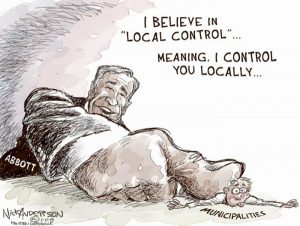 Statewide, there’s a growing backlash to Austin’s attempt to take away any and all vestiges of traditional Texas home rule local control. What started with protecting the gas industry has now swept up everything from trees to immigration and many Texas citizens, even conservative ones, are aghast at the result.
Statewide, there’s a growing backlash to Austin’s attempt to take away any and all vestiges of traditional Texas home rule local control. What started with protecting the gas industry has now swept up everything from trees to immigration and many Texas citizens, even conservative ones, are aghast at the result.
Environmentalists and fracktivists need to take advantage of this shift in the swing of the pendulum. In 2017 all of our efforts to clean-up the gas industry begin and end at the local level, where office holders must live with the results of their decisions side-by-side with their constituents. And yet HB40 makes any local advancement impossible. To get anywhere, to move off dead center, that law must be amended, or rescinded.
That is a multi-year, statewide effort that has to begin now if it’s to arrive in Austin in January 2019 with any impact.
To pull that off the movement will have to get over its aversion to coordinating regionally across city limits and be more proactive. So far, the fights in the Barnett have been city-by city, with no overarching alliances. Less coordination has meant less power. All one has to do is look at the anemic responses to HB40 in this year’s legislature to see how weak this strategy has made the movement.
But some hope could arrive in Austin in January 2019 in the form of an organized coalition of the self-interested promoting good-old fashioned local control, working with the victors of what could be a November 2018 mid-term “wave” election that might even reshape the Texas Legislature.
Who will be the architects of that strategy? Certainly not any of the larger national environmental groups, who’ve written Texas off and only want to collet money here, not spend it. It will probably have to be home grown with the assist of new groups like the Campaign to Defend Local Solutions that are linking-up threats to local control across the country.
It feels good for citizens to win one. And it would be nice if we could rest a while now and enjoy the victory, because they are so few and far between.
But sinking back into inaction only guarantees that another Bluestone will be showing up. If not in your backyard, then someone else’s. Now that we’ve established where the line in the sand is, it’s time to move the line forward.
Get Me To the Geeks
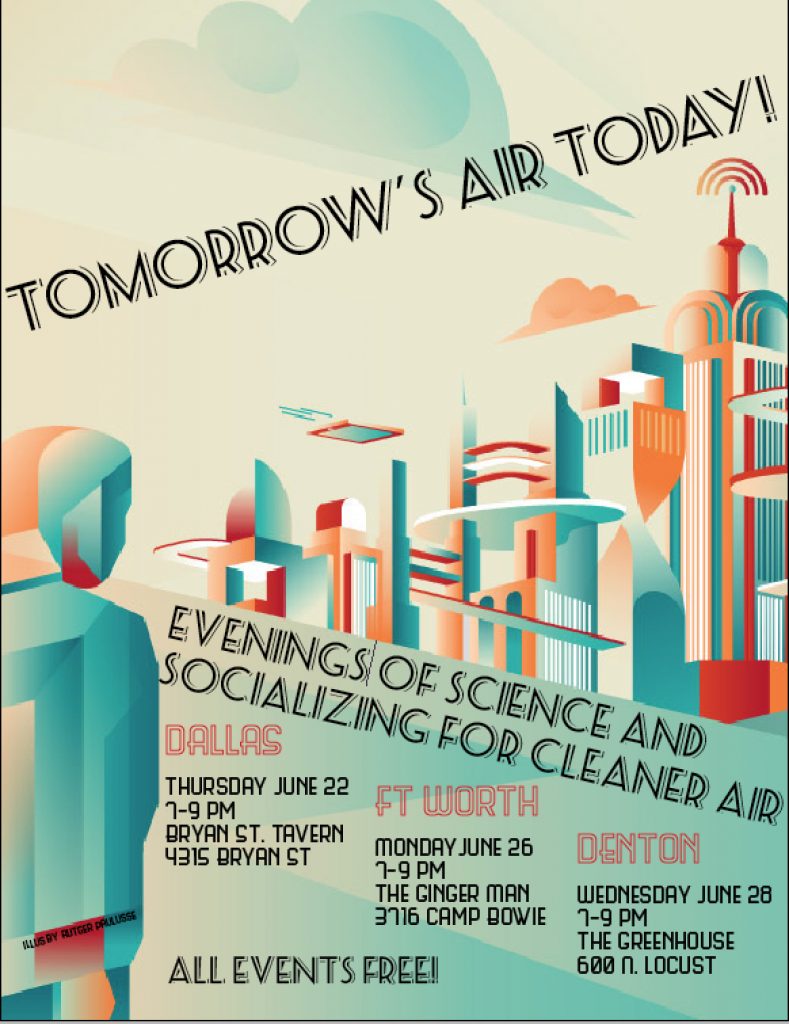
Come See How Radical The Future Really Is
3 Evenings of Exploring One of the Most Exciting Collaborations between Scientists and Citizens in the Nation while their grant is under consideration at the National Science Foundation
A consortium of N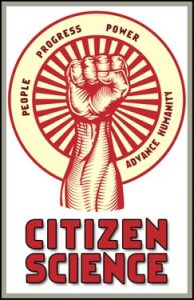 orth Texas universities, municipalities, and citizen groups, including Downwinders at Risk, is laying the foundation for a revolutionary grassroots high-tech approach to air quality monitoring that will render the current top-down system obsolete.
orth Texas universities, municipalities, and citizen groups, including Downwinders at Risk, is laying the foundation for a revolutionary grassroots high-tech approach to air quality monitoring that will render the current top-down system obsolete.
This new consortium proposes to build a dense grid of small, inexpensive air sensors that anyone can access for real-time air quality information. It’s currently in the running for a $3 million National Science Foundation grant for two local pilot projects that will do just that. It also has two other projects involving the distribution of e-sensors in DFW already in-progress. One of these is our very own Wise County Ozone Project.
It’s hard to overestimate how much of a game-changer this bottom-up approach to monitoring air pollution can become once citizens exploit its tools. Residents will be their own clean air watchdogs, asthma patients will have a huge heads-up, industrial plumes can be tracked in real time across the Metromess. Many of the ways this new effort will be most useful haven’t even been invented yet.
That’s why we’re bringing the good news of this new consortium to you in three public events.
Not only are we laying out the concept as it was presented to the National Science Foundation, but we’ll have some of the consortium’s leading researchers at each event to field your questions, and displays of some of the new generation of e-sensor air monitors being used.
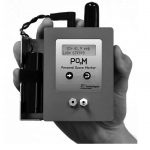 Whether you’re a asthma suffer, clean air activist, science geek, or researcher, you’ll be amazed and intrigued by the policy and public health implications of the consortium’s vision.
Whether you’re a asthma suffer, clean air activist, science geek, or researcher, you’ll be amazed and intrigued by the policy and public health implications of the consortium’s vision.
This is an opportunity to be inspired.
An unprecedented alliance is coming together in your own backyard.
Plug-in and make change happen.
Dallas
Thursday, June 22
7-9 pm
 Bryan Street Tavern
Bryan Street Tavern
4315 Bryan Street
SPECIAL GUEST:
Dr. David Lary University of Texas at Dallas
Dr. Lary is the DFW Air Research Consortium’s leading expert on environmental sensors. He’s the founding Director for Multi-Scale Intelligent Integrated Interactive Sensing Center for Space Science at UTD. He has extensive experience with both stationary sensors and use on mobile platforms, including drones.
Fort Worth 
Monday June 26th
7-9 PM
The Ginger Man
3716 Camp Bowie Blvd
SPECIAL GUEST:
Dr. David Sterling
University of North Texas
Health Science Center
Dr. Sterling has more than 30 years experience as a public health investigator. Much of his research has focused on environmental exposures in low-income communities. Dr. Sterling’s current research centers on asthma management in a school environment, and assessing how communities perceive and react to air quality issues. He’s worked extensively with the Ft. Worth League of Neighborhoods in identifying resident concerns and needs in reading and using air quality data.
Co-Sponsored by the Forth Worth League of Neighborhoods

Denton
Wednesday, June 28th
The Greenhouse
600 North Locust
Double Feature for the Host City of the
Worst Smog Monitor in the Region
Leslie Allsop MSN, MPH UNT Health Science Center
Ms. Allsop is a doctoral student at UNT’s Health Science Center and has worked for years with skeptical North Texas citizens groups to build community acceptance and effectively use the data provided by a new system of sensor air monitoring.
Dr. David Lary
University of Texas @ Dallas
Transformational National Science Foundation Grant for 21st-Century Air Monitoring Gets a Call Back
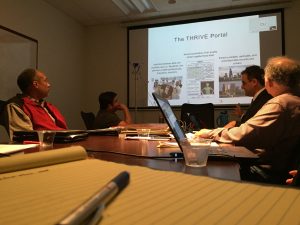 In a milestone for the local consortium Downwinders At Risk is working with to bring DFW air quality monitoring into the high-tech era, its $3 million request to the National Science Foundation for funding two pilot projects got a call-back last week.
In a milestone for the local consortium Downwinders At Risk is working with to bring DFW air quality monitoring into the high-tech era, its $3 million request to the National Science Foundation for funding two pilot projects got a call-back last week.
Led by University of Texas at Dallas high tech guru Dr. David Lary, the group includes scientists and researchers from the University of North Texas and UNT’s Health Science Center, Texas Christian University, the cities of Dallas, Fort Worth Plano and Richardson, the Fort Worth Independent School System, the Dallas County Community College District, the Fort Worth League of Neighborhoods, Livable Arlington, Mansfield Gas Well Awareness, and Downwinders at Risk.
There were said to be over 200 applicants applying for the NSF’s “Smart and Connected Cities” grant when the deadline passed about a month and a half ago. The NSF isn’t revealing how many of them got a follow-up “Virtual Site Tour” of the proposal, but the number isn’t believed to be very large. Rumor has it that one of the main competitors to the DFW proposal is Argonne National Laboratories, a 70-year old gigantic research industrial complex born out the Manhattan Project.
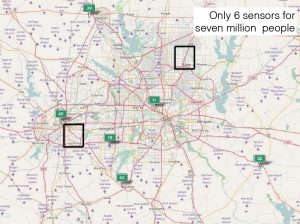 That a group that wasn’t even in business a year ago is now in the running with such a Colossus in a very competitive nationwide talent contest for valuable and scarce research dollars is pretty remarkable on its own. What makes it even more remarkable is that staff at the NSF itself actively discouraged the DFW project from even applying, because they didn’t think the proposal could compete with the scientific heavies already in the race.
That a group that wasn’t even in business a year ago is now in the running with such a Colossus in a very competitive nationwide talent contest for valuable and scarce research dollars is pretty remarkable on its own. What makes it even more remarkable is that staff at the NSF itself actively discouraged the DFW project from even applying, because they didn’t think the proposal could compete with the scientific heavies already in the race.
But what the NSF staff underestimated was how much the DFW project challenges and changes the status quo from the bottom up. It’s hard to imagine a proposal that has the potential to deliver more benefits to more people. 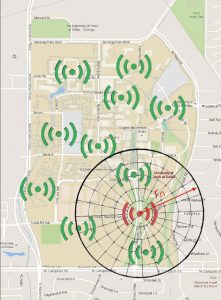
At the heart of the vision for the DFW grant proposal is the idea of an independent network of hundreds, then thousand of small e-sensors placed in a thought-out grid across the entire urban core of the Metromess. These sensors would be located every kilometer or even half-kilometer, block by block, down major thoroughfares, by schools and parks and daycare centers, by facilities that pollute.
So instead of relying on a handful of clunky large official EPA/TCEQ monitors scattered over an area the size of a couple of New England states, you know have data from just outside your own door.
Moreover these sensors would be able to deliver information about air quality in real time to an app on your phone or computer. Contrast this with the two-and-a-half hour wait between sampling and result you see on the official monitor websites now.
But wait, there’s more. As part of the app, you’re made aware of local conditions via an avatar or virtual human, who you can design yourself from a number of attributes. It will present you a list of health symptoms the poor air quality might trigger. But this avatar is also interactive through the network “portal.” You can upload your own symptoms when you’re having a bad air day. The software will look for correlations – wind direction and speed, concentrations of pollutants and allergens in the air, etc. and alert you when days are shaping up to be like the ones that give you trouble.
In the same way many of us now check the weather forecasts, pollen counts, and ozone alerts to know if we need to take extra care with our lungs, you can use this network and software to fine tune that investigation to a degree never before possible.
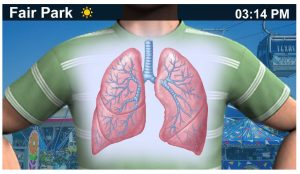 Want to be a neighborhood air pollution watch cop? Use the software to track down hotspots you didn’t even know existed, or enforce the permits issued to local facilities. The network of sensors allows you to track plumes in real time as they cross county and city boundaries.
Want to be a neighborhood air pollution watch cop? Use the software to track down hotspots you didn’t even know existed, or enforce the permits issued to local facilities. The network of sensors allows you to track plumes in real time as they cross county and city boundaries.
This is all administered by an independent group of researchers, colleges, scientists, municipalities, and public health specialists, not the State of Texas or EPA. And it’s all made possible by the same leaps in technology behind smart phones, smart cars, and even smart refrigerators: the ability to cram larger and larger tech capacities into smaller microchips and sell them for less money.
While the aim is to grow a huge network of sensors, the submitted NSF grant proposal calls for establishing two separate smaller pilot project grids of 40 sensors a piece – one grid in Southeast Fort Worth and one in Central Plano.
As the proposal explained, the differences in these two communities represent different ways to use the sensor network.
SE Fort Worth is a predominantly African-American and Latino neighborhood with documented high childhood asthma rates, high absentee rates in its schools, and for much of the year lies downwind from the Midlothian cement plants.
There the network can demonstrate how it can become a household health consulting tool, as well as empower neighborhood groups to address micro and macro-level air quality problems. Downwinders at Risk’s role in SE Fort Worth is yoking the high tech sensor network with traditional community organizing. In effect, we’re creating a new citizens tool for cleaner air and a brand new guide on to how to use it to get results.
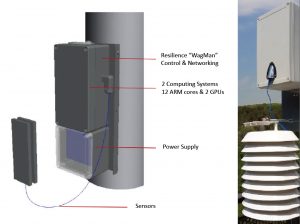 In Plano, city officials want to use the sensor network to help traffic flow and minimize vehicular air pollution. Smart technology is already being installed in the city’s infrastructure, so it’s not a huge leap to imagine installing their 40 sensors on a major roadway for 40 blocks in a row to see how traffic light timing and other variables can be adjusted to minimize internal combustion transportation pollution.
In Plano, city officials want to use the sensor network to help traffic flow and minimize vehicular air pollution. Smart technology is already being installed in the city’s infrastructure, so it’s not a huge leap to imagine installing their 40 sensors on a major roadway for 40 blocks in a row to see how traffic light timing and other variables can be adjusted to minimize internal combustion transportation pollution.
When you begin to realize that the system can not only report conditions, but learn from them and apply that learning to being able to guide not only your own personal health, but the public health policy for millions, you realize how transformational this technology can become. It has the potential to be the most important tool in fighting for cleaner air that we’ve ever seen – because it works from the bottom up and puts the power to change things in the hands of individuals instead of agencies.
We don’t always have to fight the bad guys head on – we can go around them. We can replace them. That’s what makes this network so sublimely subversive. It just leap frogs over an obsolete, regressive status quo.
We should know by the end of next month whether the participants in last week’s call were persuasive enough to convince the NSF to fund the DFW project. Regardless of that decision, the same consortium of colleges, cities and citizens groups is committed to building-out their own 21st-Century air quality monitoring network.
Today is the Third Ozone Action Day In a Row: the State really wants you to contribute to us
This year, every time
the State of Texas
declares an
“Ozone Action Day”
We want you
to take action
by donating as little
as $5 bucks to Downwinders
_______________________________________
MONDAY, MAY 15th – The last three days in a row, and the last 4 out of 8 days have been Ozone Action Days in DFW.
Yesterday’s wind speed kept things to a duller roar, but the smog was just bad enough to push up our regional average and make sure that we’ll spend another year in violation of the Clean Air Act, no matter what else happens this summer.
That’s right, it’s only May but the smog on Sunday was bad enough for long enough in Denton yesterday to make sure the 3-year average went over the current 75 ppb standard to 77.
And we still have June, July, August and September to go.
Downwinders at Risk has been working for cleaner air here in DFW since 1994. No group has been more successful in winning pollution cuts from local industry. But these victories don’t come easy or cheap.
We’re entirely local. We depend on local donations to support the only full-time staff devoted to improving North Texas air quality.
We started this new fundraising campaign because Ozone Action Days are the most obvious signs of failure of the state’s do-nothing approach to DFW’s chronic smog problem.
When smog gets bad now, there’s something you can do that’s guaranteed to make them mad in Austin: making sure Downwinders sticks around and continues to advocate for your lungs.
We appreciate your support and promise we’ll keep fighting hard for safe and cleaner air.
To make the Powers That Be angry, please donate to help Downwinders become an even more effective advocate for safe and legal air.
Downwinders Spotlighted as part of Goldman Prize Celebration
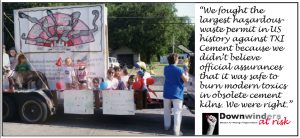 Economics and Physics has the Nobel. Journalism has the Pulitzer. Environmentalists have the Goldman.
Economics and Physics has the Nobel. Journalism has the Pulitzer. Environmentalists have the Goldman.
The Goldman Prize is the world’s largest award honoring grassroots environmental activists. It’s awarded to six activists every year – one on each continent. Winners are selected by an international jury who receive confidential nominations submitted by a worldwide network of environmental organizations and individuals. Since the it was established in 1989, a total of $15.9 million has been awarded to 157 honorees from more than 79 countries.
Last month the 2017 Goldman Prize winners were announced and two of the recipients echo local fights of our own, briefly turning the spotlight on Downwinders’ beginnings as a group fighting the burning of hazardous waste in the local Midlothian cement kilns.
Uroš Macerl, an organic farmer from Slovenia, successfully stopped a 130-year old LaFarge cement kiln from co-incinerating pet coke with hazardous industrial waste by rallying legal support from fellow Eko Krog activists and leveraging his status as the only citizen allowed to challenge the plant’s permits.
As part of the celebration of his winning, global anti-incineration group GAIA is hosting a page featuring other cement kiln warriors and of course no such page would be complete without a mention of Downwinders. Answering the question posed by GAIA of “Why We fought?” the memorial features the Downwidners float in the 1995 Duncanville Fourth of July Parade with the statement the “We fought the largest hazardous waste permit in US history against TXI cement because we didn’t believe official assurances that it was safe to burn modern toxics in obsolete cement kilns. We were right.”
The North American Goldman winner was Mark Lopez who was recognized for his role in closing down, and then getting a clean-up of the Exide lead smelter on Los Angeles’ East Side. That would be the same Exide corporation that operated an outlaw lead smelter in Frisco until Downwinders and its affiliate Frisco Unleaded teamed up to close it down in only nine months back in 2012.
Downwinders salutes all the Goldman Prize winners but wonders if anyone on either coast will take note of what this “little group that could” has done here in the belly of the beast over the last two decades? If you agree we’re at least worth the consideration, won’t you please throw some money into the hat. We’ve still got Giants to slay.
Lege Slashes Air Quality Budget…Making Our Wise County Citizen Science Project More Important
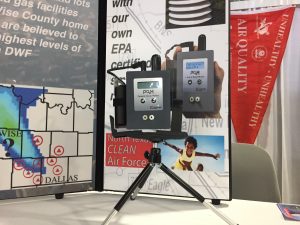 Not to be outdone by the Trump Administration’s attempted deconstruction of the Clean Air Act, the Texas House of Representatives voted in early April to take $20 million from the Air Quality Division of the Texas Commission on Environmental Quality and spend it on an alternatives to abortion program.
Not to be outdone by the Trump Administration’s attempted deconstruction of the Clean Air Act, the Texas House of Representatives voted in early April to take $20 million from the Air Quality Division of the Texas Commission on Environmental Quality and spend it on an alternatives to abortion program.
$20 million may not sound like much in a an office that has a $191 million budget, but a lot of that total is dedicated to programs in place around the state. For example, over $150 million is set aside for vehicle “emission reduction” grants to local governments in smoggy non attainment areas like Houston and DFW to subsidize new engine and repairs. A lot less is truly discretionary and a lot more at risk.
For example, TCEQ only spends a little over $6 million on grants for air monitoring. And it doesn’t get all that much bang for its buck. Only 20 monitors record smog levels over ten counties where seven million people live in DFW. This leaves huge gaps where there should be monitors but aren’t. Like Wise County.
Only Wise County isn’t just an unintentional gap in smog data. It’s a premeditated black hole, left there by design by the same TCEQ whose job it is to set-up air quality monitoring in DFW.
Over at least the last two decades, model after computer model has shown Wise County to have among the highest, if not the highest smog levels of any county in the DFW non-attainment area. Yet every time the state had the opportunity to locate a monitor to confirm those models, it passed. Why?
Because the higher the smog levels officially recorded in DFW, the more industry needs to reduce pollution by adding controls or replacing obsolete equipment.
As it is, a single tiny part per billion difference in our regional smog level was responsible for North Texas getting an exemption to turn in any plan at all for the new, and newly-endangered, 70 ppb federal ozone standard. We’re at 80. If we’d been at 81 ppb we would have had to turn in a plan. Probably a terrible one, but still a plan. A plan we could then use for court fodder to maybe get something. Now even that slim piece of leverage is gone. It’s very possible monitors in Wise County would have given us an average of 81 or greater, forcing DFW to write a plan for the brand new standard. And that’s why the current TCEQ doesn’t want a monitor there. 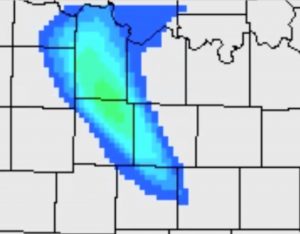
Which is why we’re going there with our own smog monitors.
We just invested $10,000 in two EPA-calibrated ozone sensors that we’re dedicating to the job of measuring Wise County smog. The monitors got their own display at Earth Day and their own photo shoot at D magazine for an upcoming article. Stay tuned for Texas Observer coverage as well. Meanwhile, here’s Culture Map’s piece.
The easiest part is done – we bought the equipment. Now we need your help in building what may the biggest and most important citizen science project in North Texas.
We’ll be launching our effort in June but we need people now who can help us build a stationary, internet-connected monitor for a location in Wise county and others who live in or near there who can help drive and take measurements from a car along a specified grid. This is your chance to actually join others and strike back against the Empire on a 24/7 basis using….SCIENCE!!!
If you’re interested in volunteering to be a Wise County Smog Tracker or want help with the Project in any capacity, please contact us at downwindersatrisk@gmail.org. Thanks.
Trump is Rolling Back Smog Standards. Get Your Anger On The Record.
What: EPA Rollback of Smog Standards – and Everything Else
Action: Submit Public Comments here ASAP
In accordance with Executive Order 13777, titled “Enforcing the Regulatory Reform Agenda,” establishing a federal policy “to alleviate unnecessary regulatory burdens,” the Trump EPA is now seeking ways to “repeal, replacement, or modify” existing regulations. Among the most prominent targets are newly-implemented smog standards and pillars of the Clean Air Act.
This follows a similar order in January, that despite coming out of the Commerce Department, was also squarely aimed at the EPA, with 48 of the 168 comments received specifically mentioning Clean Air Act regulations and 31 called for reconsidering the New Source Review process that insures continued progress in control technology.
Initially the conversation was between the regulated and regulators. But now comes the opportunity for the rest of us to officially comment. Since industry has had a considerable head start we need to make sure this public record can’t be used by the Trump Administration to justify the dismantling of the EPA.
Before they begin trying to take apart the EPA, the Trump Administration has to get public comment. You must submit your comments through the reguations.gov site. You must submit them on or before May 15, 2017.
In case you need a quick thumbnail “Hell No!,” here’s some language you can cut and past right into the regulations.gov text box online and be done with it:
As someone who lives in a region that hasn’t complied with the Clean Air Act since 1991, I reject any roll back of existing EPA regulations concerning federal ozone standards, as well as oil and gas facility emissions, greenhouse gas emissions, cement and coal plant emissions, or other large sources of air pollution. EPA should be working to protect public health, not conspiring with polluters to make regulations weaker or disappear. Improvements in air quality are documented to improve economic productivity and growth. Public health is the first priority. Keep your hands off current EPA regulations.
Trump’s Administrative Orders are just one front in the assault on Obama-era environmental regulations. Another tactic is refusing to defend new regs in court cases where industry is challenging them.
That’s exactly what happened in early April when the EPA backed out of arguing for the new 70 ppb ozone/smog standard in front of the U.S. Court of Appeals for the District of Columbia Circuit that was slated to hear oral arguments. In its filing, the Agency stated, “At this time, EPA officials appointed by the new Administration are closely reviewing the 2015 Rule to determine whether the Agency should reconsider the rule or some part of it….Given the broad-reaching economic implications of the 2015 ozone standard, we are carefully reviewing the rule to determine whether it is in line with the pro-growth directives of this Administration,” an EPA spokesperson, J.P. Freire said.
As the Oklahoma Attorney General, EPA Administrator Scott Pruitt joined Texas and eight other states in unsuccessfully fighting the initial implementation of the standards, which they said were unnecessary to protect human health. An EPA Science panel had concluded the opposite, stating lowering the standard from 75 to 70 parts per billion was the minimum necessary to protect health, and advised a more aggressive standard of 60-65 ppb, which even the Obama Administration recoiled from implementing before the 2012 election.
However, what the Trump Administration is now proposing is a roll back from the new 70 ppb standard, either by official repeal or unofficial non-enforcement, to the current 75 ppb, which will also probably be “loosely” enforced. That standard was found to be “not protective” of public health.
Because the Clean Air Act specifically says the standard must be science-based and any deviation will be headed to court, a permanent roll back is less likely than just ignoring the law, but the damage will be the same in the meantime.
In DFW this means that the current smog planning process, which had the potential to do so much good with a federal substitution of the state’s second do-nothing plan, is now DOA. That plan was another attempt to just get the region down to 75 ppb, the old standard. It didn’t even address the new 70 ppb standard now in jeopardy. We’re currently at a regional average of 80 ppb.
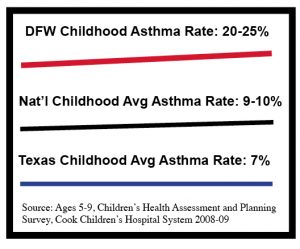 No EPA or state order will be overseeing the implementation of new controls on major sources affecting DFW air quality like the Midlothian cement kilns, East Texas coal plants or gas patch facilities, or action of any kind. Citizens will probably have to sue to get the EPA to even reject the state plan now – something it was already on the public record saying it was ready to do prior to November 20th. That rejection will, however, only trigger a rewrite by Austin. 14 million DFW lungs are now trapped by a vicious cycle of inaction that both the state and federal government are fueling.
No EPA or state order will be overseeing the implementation of new controls on major sources affecting DFW air quality like the Midlothian cement kilns, East Texas coal plants or gas patch facilities, or action of any kind. Citizens will probably have to sue to get the EPA to even reject the state plan now – something it was already on the public record saying it was ready to do prior to November 20th. That rejection will, however, only trigger a rewrite by Austin. 14 million DFW lungs are now trapped by a vicious cycle of inaction that both the state and federal government are fueling.
Other attempts by the Administration to attack the efficacy of the Agency are more structural. Seemingly with no more than spite as a motivation, there was a report circulating last month the Chicago regional EPA office would be shut down and consolidated with its Kansas City peer, with a corresponding cut in staff and resources. That’s not likely to happen for a variety of reasons, but it shows the kind of opportunistic thinking driving Agency opponents to start a fire sale. This Administration will probably not withdraw from the Paris Climate Accords, but it can be successful in blunting any EPA attempt at actual environmental protection.
That’s why it’s important not to let the opportunists at the Trump EPA win the day. We need to make sure they get a loud and clear message not to mess with the Clean air Act or anything else. Don’t hesitate. Communicate your outrage now, where it will be counted by both sides. Thanks.
A Guide to Downwinders & Everything Else @ Earth Day Texas 2017
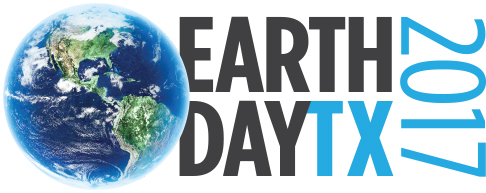 Earth Day Texas 2017 at Fair Park this weekend offers you plenty of chances to catch up with Downwinders and see us in action. It also offers you more information and discussions and multimedia experiences than anyone person could possibly get around to in 72 hours, no matter how committed.
Earth Day Texas 2017 at Fair Park this weekend offers you plenty of chances to catch up with Downwinders and see us in action. It also offers you more information and discussions and multimedia experiences than anyone person could possibly get around to in 72 hours, no matter how committed.
So here’s not only where to find us, but some other interesting things that overlap with our program work, past events, or just seem cool.
Beginning this coming Friday you can come by and see one of our new EPA-calibrated ozone monitors up close and personal at our booth in Centennial Hall – 5010. Downwinders’ Wise County Ozone Project is looking for folks to help us pull-off one of the largest, and most important citizen science projects ever attempted in North Texas. Stop by and see the little piece of equipment that’s not afraid to go where the state fears to tread.
On Friday morning you can catch Downwinders at Risk Director Jim Schermbeck participate with Railroad Commissioner Ryan Sitton and others in a UTA/CLEAR-sponsored roundtable on Fracking in Texas 10:50-11:40 am inside the Automotive Building. Since a community forum on the Bluestone Injection Well on Lake Arlington will have happened in Fort Worth the night before, that topic is sure to still be on the front burner during this discussion. This ro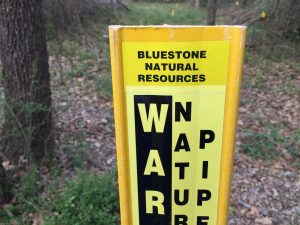 undtable is just one of a long list of events being sponsored as part of first annual Responsible Shale Energy Extraction Symposium happening Friday and Saturday.
undtable is just one of a long list of events being sponsored as part of first annual Responsible Shale Energy Extraction Symposium happening Friday and Saturday.
Also on Friday morning, continuing on into the later afternoon is a running series of discussions and presentations on climate change in the Automotive Building featuring a 90 minute discussion on carbon pricing starting at 12:15 pm, followed by Susan Eisenhower at 1:30 to 2 pm and former General Wesley Clark from 2:30 to 3:30 pm.
From 2:30 to 3:30 pm on Friday at the Grand Place, theres a roundtable on “Youth and the Environment.”
Saturday morning beginning at 10 am the March for Science will snake its way from Downtown Dallas to Fair Park with an ETA of 2 pm, where GreenSource DFW is sponsoring a climate rally at the the Band Shell.
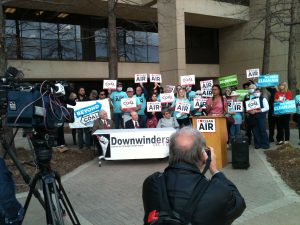 On Saturday, from 4:45 to 5:45 pm Downwinders’ Schermbeck facilitates a discussion about Dallas Air Quality between people with lots of initials after their names, including Dr. Robert Haley, nationally-recognized UT Southwest epidemiologist and coal plant fighter, Dr. David Lary, the guru of high tech air monitoring at UTD, and Dr. Natalie Johnson, a Professor of Environmental and Occupational Health at Texas A&M.
On Saturday, from 4:45 to 5:45 pm Downwinders’ Schermbeck facilitates a discussion about Dallas Air Quality between people with lots of initials after their names, including Dr. Robert Haley, nationally-recognized UT Southwest epidemiologist and coal plant fighter, Dr. David Lary, the guru of high tech air monitoring at UTD, and Dr. Natalie Johnson, a Professor of Environmental and Occupational Health at Texas A&M.
Saturday morning from 10:15 to 11:15 offers you a chance to see RRC Commissioner Sitton’s road show, with a 30 minute spiel on the oil and gas industry up front, and a Q&A session afterwards.
Across the Esplanade in Centennial Hall from 10 to 11 am there’ll be a debate between Log Cabin Republicans and Stonewall Democrats.
From 12 to 12;30 on Saturday pm Tech Tech prof and Climate Change Celeb Dr. Katherine Hayhoe will speak at Centennial Hall.
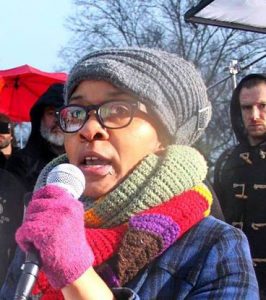 Saturday night at 7:30 pm in the lovely Fair Park Music Hall is a screening of “Bigger Than Water,” the definitive film on the Flint Water Scandal to date featuring Flint Democracy Defense League organizer Nayyirah Shariff, who was Downwinder’s special guest in January for our Root and Branch Revue conference for activists.
Saturday night at 7:30 pm in the lovely Fair Park Music Hall is a screening of “Bigger Than Water,” the definitive film on the Flint Water Scandal to date featuring Flint Democracy Defense League organizer Nayyirah Shariff, who was Downwinder’s special guest in January for our Root and Branch Revue conference for activists.
Sunday morning beginning at 11 am sees what’s bound to be a popular presentation on Tiny Houses in the Grand Place, while a workshop on Protecting Praries takes place at the same time in the Tower Building.
From 3:30 to 4:30 pm on Sunday there’s a roundtable on “Trinity Tribulations” in the Automotive Building and the EDTx Earth Pitch competition wraps up with the Academic and Non-profit divisions from 12:30 to 3 pm.
Exhausted? That’s not even skimming the surface. Whatever you decide to prioritize, allow yourself some time to just wander around.
Downwinders Buys Smog Monitors to Go Where No Smog Monitor Has Gone Before: Wise County
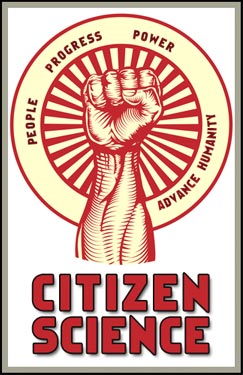 On the eve of Earth Day, clean air group Downwinders at Risk announced the purchase of two portable, EPA-calibrated ozone monitors to initiate a citizen-based monitoring campaign in Wise County this summer, where state officials refuse to measure DFW smog.
On the eve of Earth Day, clean air group Downwinders at Risk announced the purchase of two portable, EPA-calibrated ozone monitors to initiate a citizen-based monitoring campaign in Wise County this summer, where state officials refuse to measure DFW smog.
“With the purchase of these brand new high-tech monitors, which reached the market only a few months ago, we become the first group in Texas to have the capability to go out in the field and do the job the State of Texas isn’t willing to do,” said Downwinders Chair Tamera Bounds.
Downwinders newest technology will be on display at this weekend’s Earth Day Texas at Fair Park, where it’ll be a featured part of the group’s information booth. Each monitor cost approximately $5,000, fits in the palm of your hand, and comes with EPA-certified calibration to ensure reliable readings.
Wise County became the newest member of DFW’s almost-30 year “non-attainment” area for smog, or ozone pollution, in 2012. But despite computer models showing the County having some of the highest smog levels North Texas, there’s still no smog monitor located there.
Surprisingly, EPA regulations don’t require even a single ozone monitor in every non-attainment county, and Wise County is the only one of the ten DFW non-attainment counties not to have one. Bounds and her fellow clean air activists don’t believe that’s a coincidence.
Currently the Texas Commission on Environmental Quality (TCEQ) picks the sites where smog monitors are located. Denton’s airport monitor has recorded the highest levels of smog in DFW the last few years. But because of wind direction and its large number of pollution sources, computer models predict even higher levels of smog in Wise County.
That’s important because the size and scope of local clean air plans are determined by how high or low smog readings are in North Texas. The higher the smog levels, the more cuts in pollution from coal plants, cement kilns, and gas industry facilities are required to comply with the Clean Air Act.
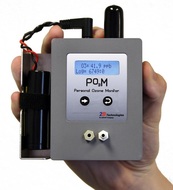 Not surprisingly, spoke persons for those industries claim such cuts aren’t needed, but the state has made the same claims despite evidence from their own computer models showing new controls could bring the area into compliance with the Clean Air Act for the first time since 1991. TCEQ also takes the position, contrary to the medical consensus, that smog isn’t bad for public health.
Not surprisingly, spoke persons for those industries claim such cuts aren’t needed, but the state has made the same claims despite evidence from their own computer models showing new controls could bring the area into compliance with the Clean Air Act for the first time since 1991. TCEQ also takes the position, contrary to the medical consensus, that smog isn’t bad for public health.
Bounds believes the TCEQ doesn’t want a smog monitor in Wise County precisely because it’d record even higher levels of the pollution than current monitors are picking up and trigger regulatory requirements to make bigger cuts.
“By not measuring smog in the place it’s predicted to be the worst, what we don’t know is hurting us,” she explained.
“Because TCEQ’s priority is to protect a handful of industrial polluters at the expense of seven million DFW residents we’re getting clean air plans based on one, rosier set of numbers, while the actual pollution levels are probably higher. That’s one reason why we’ve been in continual violation of the Clean air Act since 1991.”
Downwinders Director Jim Schermbeck said the two monitors, and others the group is buying, would be used both in stand-alone stationary locations within the County and by vehicle and drone -based platforms. They can be adapted to provide wireless connections and be plugged-in to larger networks of citizen-based monitors – something already being designed by a consortium of local universities, municipalities, and citizen groups co-founded by Downwinders.
On “high ozone days,” Downwinders will scramble a crew of citizen scientists to record ozone levels in Wise County a nd compare their results to those from other DFW monitors.
nd compare their results to those from other DFW monitors.
Besides giving the public and policymakers a more realistic view of DFW smog levels, Downwinders hope to put pressure on the EPA and the State to place one or more official ozone monitors in Wise County. Schermbeck said the group’s efforts at identifying patterns or hotspots in the County would help clean air advocates find the best place to put such a monitor.
Although the purchased monitors only arrived on the market in January, Downwinders’ Wise County Ozone Project has been over a year in planning.
It was as last year’s Earth Day Texas that Downwinders won a $3000 prize with its proposal to use small electronic air sensors combined with drone technology to provide better air pollution measurements across DFW. Wise County smog was one of the specific examples used in the presentation.
Downwinders used the Earth Day Texas funding as seed money to attract other support to fund its own North Texas CLEAN Air Force – a citizen science campaign whose first target is Wise County smog. With the purchase of the monitors, it’s believed to be the only citizens’ group in the state with the ability to independently measure ozone pollution with its own devices, much less with EPA-calibrated instruments.
Schermbeck says the group is looking to recruit both researchers who want to lend their professional help to the project, and those people who just want to help do their part in a local fight for cleaner air.“ Sadly, this is what it’s come down to in 2017 Texas: residents having to organize themselves into performing basic public health functions usually carried out by their state government.”

